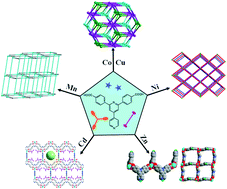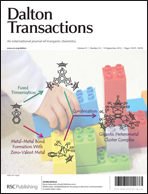Six novel metal–organic frameworks (MOFs), {Mn(bpydb)(bpyHdbH)}n (1) {[Co2(bpydb)2](H2O)0.5}n (2), {[Ni0.5(bpydbH)(H2O)](DMF)2}n (3), {[Cu2(bpydb)2](H2O)0.5}n (4), {Zn(bpyHdb)2}n (5) and {[Cd0.5(bpydb)0.5(DMF)](H2O)}n (6), were successfully synthesized by assembling transition metal salts with trigonal heterofunctional ligand 4,4′-(4,4′-bipyridine-2,6-diyl) dibenzoic acid (bpydbH2) under hydrothermal and/or solvothermal conditions. Compound 1 features a rare 4-fold interpenetrating (3,5)-connected framework with hms-type topology. Isostructural compounds 2 and 4, constructed by M2(COO)4 secondary building units, exhibit a robust 3D framework with alb topological type in 2-fold interpenetrating mode. Compound 3 consists of 2D (4,4) networks, which are further assembled into the new topological framework with the symbol (53·62·8)(53·63)2 through O–H⋯O interactions. Compound 5 manifests a novel 4-connected interpenetrating framework, constructed by 2D (4,4) layers and interbedded N–H⋯O interactions. Non-interpenetrating honeycomb networks are observed in compound 6, and further packed into a 3D framework featuring 1D channels. The magnetic susceptibility of compound 2 indicates antiferromagnetic interactions between cobalt ions. The photoluminescent properties of 5 and 6 were investigated in the solid state at room temperature.


 Please wait while we load your content...
Please wait while we load your content...